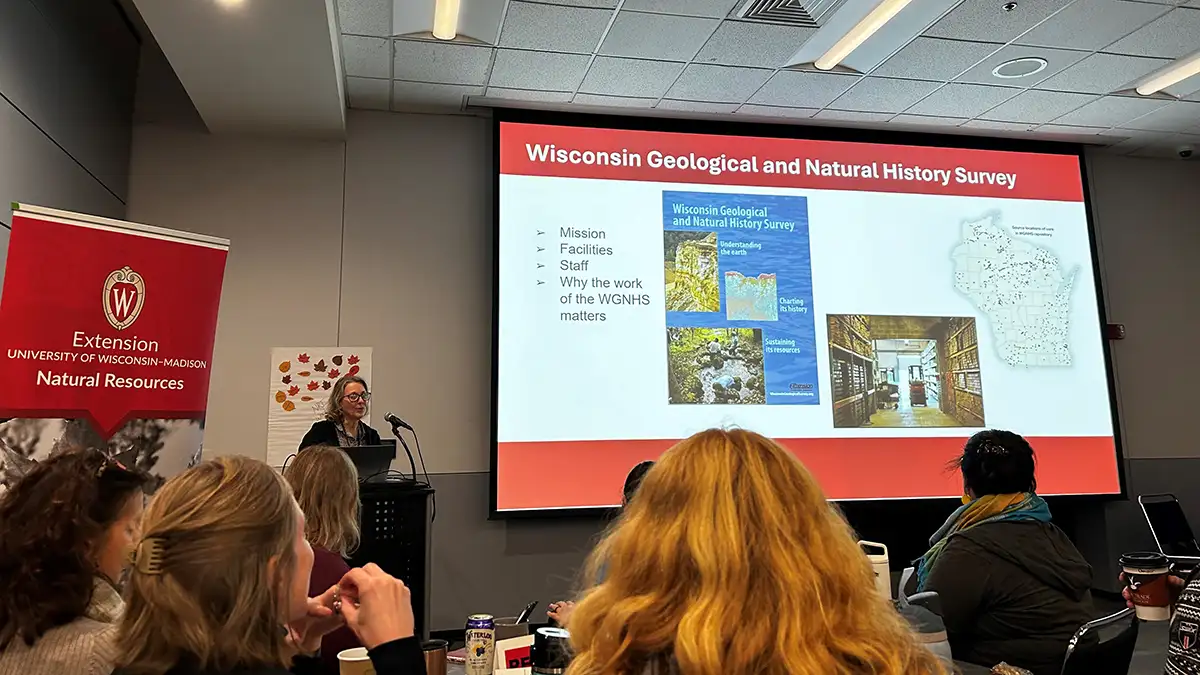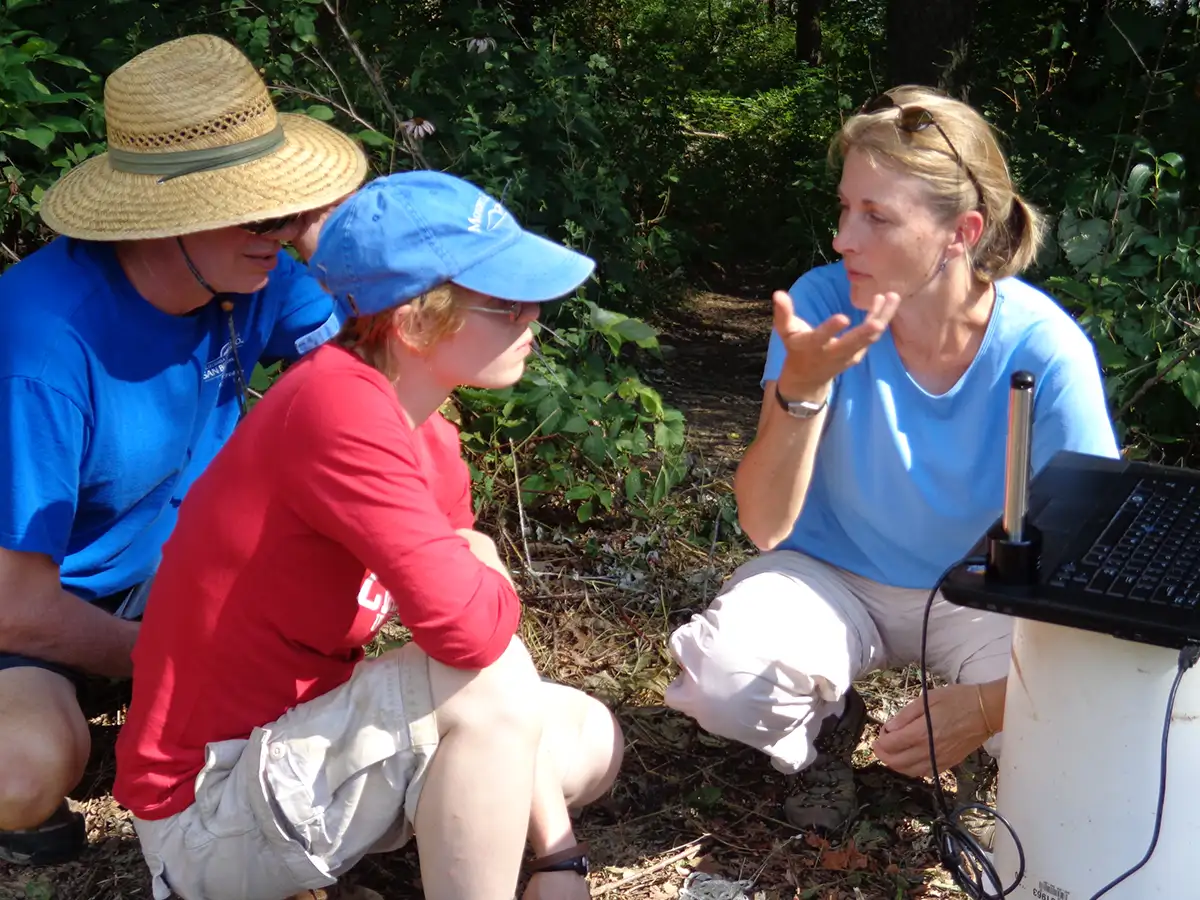Beneath the state of Wisconsin lies a vast resource. Invisible, it supports everything: from agriculture to industry to life itself. This is Wisconsin’s groundwater system. Though researchers can obtain glimpses — in boreholes or through computer modeling — the most convenient places to study groundwater are where it naturally flows to the surface: springs.
Understanding springs is critical to understanding our water resources, both below and above ground. They can tell us about our water’s quality, how contaminants move through the system, and they even create sheltered habitats for endangered species.
In 2003, the Wisconsin state legislature passed Act 310, which required tightened approvals for high-capacity wells to address quality and quantity concerns in both groundwater systems and springs. “That was a way to hopefully help protect … the unique aquatic ecology that springs support,” says Sue Swanson, director of the Wisconsin Geological and Natural History Survey. “The problem was … we didn’t know where many of the big springs were.”
This set Swanson and her team on a three-year journey, traversing public and private lands across Wisconsin’s 72 counties, to create the first statewide springs inventory. This inventory, still regularly used today, changed Wisconsin’s groundwater game — and brought the invisible to the surface.
Water, Water, Somewhere
Swanson’s career has been built in and around water. Now the state geologist and director of the Wisconsin Geological and Natural History Survey (WGNHS), her earliest water memories were of exploring the pond at her childhood home, a small farm in northern Illinois. “The experience of growing up in a space where there was room to roam piqued my interest in resources,” she says. “When I went off to college, I looked for opportunities to continue to be able to engage with nature,” which she found at Gustavus Adolphus College in St. Peter, Minnesota. After completing her undergraduate studies in geology and biology, she entered the Peace Corps.
The diversity of geologic environments and landscapes is really exciting … There’s something really remarkable in every corner of Wisconsin.
– Sue Swanson
It was then, while teaching math and science in Lesotho, a sovereign kingdom encircled by South Africa, that she experienced the vast disparities that exist in both water quality, quantity, and access. She also quickly realized that a key component to successful teaching is connecting the material to the students’ lived experience. “There were many aspects of life that were very different from Northern Illinois,” she remembers thinking. So, what does it mean to learn about geology here? “That’s where I honed in on my interest in the applied aspects of you know geology,” she says, “and that is what led me to water resources management.”
Seeking a master’s degree, Swanson flowed some 9,000 miles northwest to a new habitat: the University of Wisconsin–Madison and its Nelson Institute for Environmental Studies. She enrolled in the water resources management program, which is entering its 60th year. A hallmark of the WRM program is its cohort-based practicum, where students work directly with groups or communities across the state to address real-life water issues. “Coming into the program, I saw the diversity of coursework as a real asset,” she says. “And then the practicum brought it all together.”
Research Springs Eternal
Over its 60-year history, past WRM practicum projects have investigated enhanced water quality in a Madison-area watershed, worked on wetland restoration in New Orleans following Hurricane Katrina, and even set guidelines for sustainable road salt usage on the UW–Madison campus. Most cohorts have about 6 to 10 students with unique interests or expertise areas. Swanson’s 1996 cohort was a big one — 17 students in total, learning how to both apply science and work in a team. Their site? Madison’s Nine Springs Creek watershed, located just south of the beltline highway about five miles off campus.
The cohort completed an assessment of the watershed’s current state, with an eye towards future management. Standing on the banks of the creek and looking north, Swanson could see and hear Madison’s urban expansion. A 180-degree turn, and she’d be looking over vast farmland and open parcels. “I think a lot of [us understood] the opportunity to actually have some measure of impact on how this area might be managed going forward. I see that as something that made that project successful, but also accessible,” she says. “Now, of course, that area is very different.”

Systems of subdivisions — even a new school — meld the borders between Madison and Fitchburg. When Swanson visits Nine Springs today, she’s reminded of the challenges — and opportunities — of environmental work. Some of the cohort’s recommendations were pursued; some weren’t. Perhaps a combination of developer influence, societal pressures, or even just products of time, Swanson posits. During the practicum, she remembers seeing areas where reed canary grass, one of Wisconsin’s most invasive species, had started to take hold. “We all knew how aggressive it was, but there were still pockets of … really high-quality wetlands,” she remembers. “When you go to those areas now, they haven’t been preserved. Were those missed opportunities, or just a reflection of how aggressive things like reed canary grass are?”
For Swanson, Nine Springs wasn’t just a class project: it became the confluence of her academic and professional career. After earning her WRM degree and taking a short break to do consulting work, Swanson returned to the UW for a PhD in hydrogeology. When she needed a fieldwork site for her dissertation, she knew exactly where to go. “The Nine Springs work really piqued my interest in what is called ‘groundwater-surface water interactions:’ that interface where you can better understand biological systems because you understand the subsurface flow that helps to sustain them,” she explains. Her 2001 dissertation laid a new groundwork for how the field of hydrogeology understands that interaction by challenging a long-standing assumption: that sandstone aquifers could be treated as uniform and predictable. With Nine Springs Creek as a backdrop, her work revealed how subtle variations within sandstone layers could influence how groundwater moves— including where it flows most easily or where contaminants might travel.
Pair this with the 2003 legislation that recognized the importance of understanding and protecting Wisconsin’s springs. Swanson showed how much the Nine Springs Creek watershed could tell us about Madison’s groundwater. If we surveyed springs across the state, we could have a picture of water quality and quantity that could help us better plan water access, development, and even conservation efforts. The problem — a big one — was knowing where the springs were.
Unearthed Springs
With a team of researchers, Swanson set out to identify, visit, and collect samples from large springs across the state. Three years and 72 counties later, they published the first ever statewide springs inventory, tallying 415 in total. Through this work, Swanson and her team identified three types of springs that appear across Wisconsin: rheocrene springs, which create defined channels; hillslope springs, which emerge from 30-degree–plus slopes; and limnocrene springs, which flow into lakes. (If you ask her favorite, she will expertly say, “The diversity of geologic environments and landscapes is really exciting … There’s something really remarkable in every corner of Wisconsin.”)
They also collected numerous data from each spring including flow rates, orifice area, and nearby conditions (like roadways, agricultural lands, recreational trails, etc.). But for an inventory like this to be truly useful and not just a “moment in time,” these data need to be updated regularly. Today, the Wisconsin Department of Natural Resources uses Swanson’s inventory for assessing and approving high-capacity wells. They also visit a rotating 5-10 percent each year for continued data collection. “That’s the way to refine the framework that we presented at the conclusion of the inventory itself,” Swanson says. “That’s what will allow us to refine these models over and over.”

While completing the formidable task of establishing the first comprehensive framework for understanding Wisconsin’s springs — and setting the stage for further research — Swanson was also working in the position that sent her down this path in the first place: teaching. A faculty member at Beloit College for more than two decades, she practiced what she learned in Lesotho. “Teaching is not just about the content. Teaching is about making connections,” she says. This philosophy earned her numerous accolades, including an endowed chair and three teaching awards.
When the job as director of the WGNHS came up, Swanson saw the perfect opportunity to mesh research, mentorship, teaching, and outreach. She applied, and following a nationwide search, was offered the job in 2023. The WGNHS is nearly as old as the state of Wisconsin; it was founded in 1897 to conduct surveys, archive information, and communicate results to support informed decision making. Stepping in as its eighth director, Swanson is the first woman to hold the job. “There was a [woman] interim director for a few months!” she quickly clarifies, sharing the acclaim. Though she recalls many of her classes, as well as her WRM cohort, having a good gender balance, she sings the praises of the handful of women faculty members that inspired and supported her. “To have folks like Jean Bahr and Mary Anderson in the geosciences department at Madison at the time, that made a big difference,” she says.
Swanson’s career in water has left no stone unturned — or spring unmapped or sandstone layer unstudied. Now, as she leads the Survey into its next chapter, she’s also stepping into a position to inspire future environmental leaders like Bahr and Anderson did for her. “That’s an added bonus,” she humbly says. For the next generation of geoscientists seeking inspiration, in Wisconsin and beyond, Swanson may be the clearest source they’ll find.



